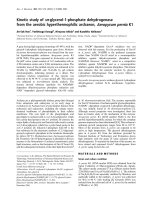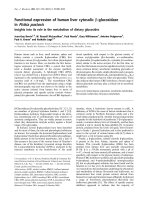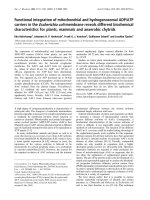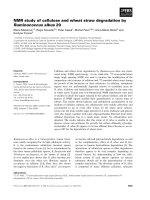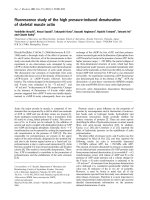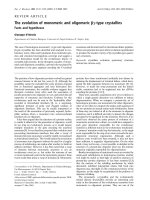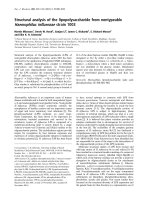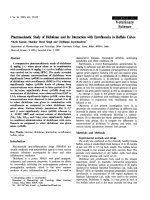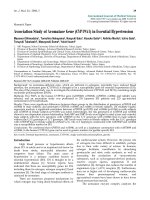Báo cáo y học: " Ethnobotanical study of wild edible plants of Kara and Kwego semi-pastoralist people in Lower Omo" docx
Bạn đang xem bản rút gọn của tài liệu. Xem và tải ngay bản đầy đủ của tài liệu tại đây (729.95 KB, 8 trang )
RESEARC H Open Access
Ethnobotanical study of wild edible plants of
Kara and Kwego semi-pastoralist people in Lower
Omo River Valley, Debub Omo Zone, SNNPR,
Ethiopia
Tilahun Teklehaymanot
*
, Mirutse Giday
Abstract
Background: The rural populations in Ethiopia have a rich knowledge of wild edible plants and consumption of
wild edible plants is still an integral part of the different cultures in the country. In the southern part of the
country, wild edible plants are used as dietary supplements and a means of survival during times of food shortage.
Therefore, the aim of this study is to document the wild edible plants gathered and consumed by Kara and Kwego
people, and to analyze patterns of use between the two people.
Methods: A cross sectional ethnobotanical study of wild edible plant species was conducted from January 2005 to March
2007. About 10% of each people: 150 Kara and 56 Kwego were randomly selected to serve as informants. Data were
collected using semi-structured questionnaire and group discussions. Analysis of variance (a = 0.05) was used to test the
similarity of species richness of wild edible plants reported by Kara and Kwego people; Pearson’sChi-squaretest(a =0.05)
was used to test similarity of growth forms and plant parts of wild edible plants used between the two people.
Results: Thirty-eight wild plant species were reported as food sources that were gathered and consumed both at
times of plenty and scarcity; three were unique to Kara, five to Kwego and 14 had similar local names. The plant species
were distributed among 23 families and 33 genera. The species richness: families, genera and species (p > 0.05) were
not significantly different between Kara and Kwego. Nineteen (50%) of the reported wild edible plants were trees, 11
(29%) were shrubs, six (16%) were herbs and two (5%) were climbers. Forty plant parts were indicated as edible: 23
(58.97%) fruits, 13 (33.33%) leaves, 3 (7.69%) roots and one (2.56%) seed. There was no difference between wild edible
plants growth forms reported (Pearson’s Chi-square test
(d.f. = 3)
= 0.872) and plant parts used (Pearson’s Chi-square test
(d.f. = 3)
= 0.994) by Kara and Kwego people. The majority of wild edible plants were gathered and consumed from
’Duka’ (March) to ’Halet’ (May) and from ’Meko’ (August) to ’Tejo’ (November). Sixteen (41%) of the plant parts were used
as a substitute for cultivated vegetables during times of scarcity. The vegetables were chopped and boiled to make
’Belesha’ (sauce) or as a relish to ’Adano’ (porridge). The ripe fruits were gathered and consumed fresh and some were
made into juices. The seeds and underground parts were only consumed in times of famine. Thirty-seven percent of
the wild edible plants were used as medicine and 23.6% were used for other functions.
Conclusions: The wild edible plants were used as supplements to the cultivated crops and as famine foods
between harvesting seasons. But information on the nutrit ional values and possible toxic effects of most of the
wild edible plants reported by Kara and Kwego, and others in different part of Ethiopia is not available. Th erefore,
the documented information on the wild edible plants may serve as baseline data for future studies on nutritional
values and possible side effects, and to identify plants that may improve nutrition and increase dietary diversity.
Some of these wild edible plants may have the potential to be valuable food sources (if cultivated) and could be
part of a strategy in tackling food insecurity.
* Correspondence:
Aklilu Lemma Institute of Pathobiology, Addis Ababa University, P. O. Box
1176, Addis Ababa, Ethiopia
Teklehaymanot and Giday Journal of Ethnobiology and Ethnomedicine 2010, 6:23
/>JOURNAL OF ETHNOBIOLOGY
AND ETHNOMEDICINE
© 2010 Teklehaym anot and Giday; licensee BioMed Central Ltd. This is an Open Access article distributed under the terms of the
Creative Commons Attribution License (ht tp://creativecommons.org/license s/by/2.0) , w hich pe rmits u nrestricted use, distribution, and
reproduction in any medium, provided the original work is properly cited.
Background
Utilization of wild edib le plants as a food source is an
integral part of the culture of indigenous people that
dwell in the rain forests of Africa and South America
[1-4] who gather and consume wild edible plants as
snacks and at times of food scarcity [5-10]. Sixteen i ndi-
genous people inhabit the south western part of Ethio-
pia; Kara and Kwego are two of these that live in Lower
Omo River Valley. They are knowledgeable of traditional
plant uses, one of which is the use of wild edible plants
as a food source [10-13].
The Kara people live in the remote section of the
Lower Omo Valley on the eastern bank of Omo River.
They have a well-kept and distinct cultural identity, and
speak the Omotic language. The Kara people use ornate
bod y art, intricate headdresses and body scarificatio n to
express b eauty and significance in the community. They
are known by their painted body and face decorations,
which are symbolic and ornamental expression. The
body painting is an elaborate process, which ranges
from fine and elaborate details to rough, but striking
paintings traced with the palms or fingers that combines
white (chalk), black (charcoal), yellow, ochre, and red
earth. They are semi-pastoralists and fishermen [11,13].
The Kwego people live on the western bank of the
Omo River at its junction with the Mago River. They
live in a symbiotic relationship with the Kara people and
speak Nilotic language, which is threatened by the influ-
ence of Bume a people. They are hunter-gatherers and
fishermen. They also grow sorghum and maize on the
shore of Omo River and collect honey from wild [11,13].
The Ethiopian flora contains appro ximately 600 0 spe-
cies of higher plants of which about 10% are endemic
[14,15]. It is known as a ‘biodiversity hot-spot’ and a
centre of origin and diversification for a significant
number of food plants and their wild relatives [16,17].
The rural populations in Ethiopia have a rich knowledge
of wild edible plants and consumpt ion of wild edible
plants is still an integral part of the different cultures i n
country. Ethnobotanical studies conducted in Ethiopia
have indicated that over 300 species of wild plants are
gathered and consumed by the people [8,10,17-22].
In the southern part of Ethiopia, wild edible plants are
used as supplements to cultivated crops and as a survi-
val strategy during food shortages that appears to have
been intensified due to low development of agriculture
and the repeated la ck of rain [10,12,19]. Nevertheless,
the Kara and Kwego people have subsisted primarily on
pastoralism and agriculture and therefore, still preserve
traditional knowledge on wild edible plants and depend
on these plant species in most of the seasons where
food shortages occur: ‘ Leamura’ (July) to ‘ Kilikila’
(December). Although the rich indigenous knowledge
on the medicinal use of plants has been relatively well
documented [8,9], studies on the knowledge of wild
edible plants in Ethiopia are limited [10,23]. The aim of
this study is to document the use of wild edible plants
gathered and consumed by Kara and Kwego pe ople, and
analyse patterns of use between the two people. The
results may be useful to identify wild edible plants that
can improve nutrition and increase dietary diversity in a
similar environment. Some of these wild edible plants
may also have the potential to be valuable food sources
(if cultivated) and so be an important strategy in t ack-
ling food insecurity.
Methods
Study sites
Kara and Kwego are located in the Lower Omo River
Valley, Debub Omo Zone, Southern Nations, Na tional-
ities and Peoples Regional State (SNNPR) at about 880
km south of Addis Ababa. The study site is ‘kola’ to
‘ bereha’ (dry arid lowland), has 400 - 600 mm mean
annual rainfall and 20.1 - 27.5°C mean annual temper a-
ture. The Kara people live in three villages: Lebok
(403.26 m.a.s.l., N 050 22′ 306′′,E36012′ 575′′), Duss
(406.30 m.a.s.l., N 050 16′ 471′′, E 360 12′ 420′′)and
Korcho (433.13 m.a.s.l., N 050 11′ 562′, E 360 12′ 428′′)
on the eastern bank of Omo River in Hamar Woreda
(District). They are bordering Hamar and Bena on the
east, Nyangatom on the west, Mursi on the north, and
Dasenech on the south. The total population of t he
three villages is 1,472 (Fig. 1).
The Kwego people live at six villages on the western
bank of Omo River in Kuraz Woreda and the total
population is 584. The location with the highest popula-
tion and the prominent residential area is Kuchuru
(406 m.a.s.l., N 050 25′ 683′′, E 360 12′ 717′′), which is
locatedatabout42kmfromKangaton.Theylive
together with Bumea/Nyangatom people. They are bor-
dering Nyangatom on the south and west, Mursi on the
north and Kara on the east (Fig. 1).
Ethnobotanical data collection
A cross sectional ethnobotanical study was conducted
from January 2005 to March 2007. About 10% of each
people: 150 Kara (female = 48, male = 112) and 56 Kwego
(female = 20, male = 36) were randomly selected using
random numbers, which were generated using Microsoft
Excel 2003, fro m households at each lo cation to serve as
informants: The Kara female informants’ age range was
from 20 years to 70 years (median = 43) and that of the
males was from 23 years to 80 years (median = 58.5). The
Kwego females’ age ranged from 20 years to 80 years
(median = 29.5) and that of males’ from 20 years to
85 years (median = 45) [24]. The data on wild edible
Teklehaymanot and Giday Journal of Ethnobiology and Ethnomedicine 2010, 6:23
/>Page 2 of 8
plants were collected using semi-structured questionnaire
and gro up discussions. The group discussions were used
to elaborate on time of farming, food scarcity and gather-
ing, and mode of consumptions. Interviews and discus-
sions were conducted with the assistance of native
translators. Information on local names of the plants, parts
of plants used, mode of consumption, preparation and
time of gathering were recorded. Voucher specimens were
collected during walks with informants. Plants were identi-
fied by experts, Meleaku Wondafrash, at the National Her-
barium of Addis Ababa University and Aklilu Lemma
Institute of Pathobiology (ALIPB). Voucher specimens
were deposited at ALIPB, Addis Ababa University.
Data analysis
Percentage, and bar and pie charts were used to sum-
marize the data. Analysis of variance (a = 0.05) was
used to test the similarity of the wild edible plant spe-
cies richness reported by Kara and Kwego people;
Pearson’s Chi-square test (a =0.05)wasusedtotest
similarity of growth forms and plant parts of wild edible
plant species used as food source betw een Kara and
Kwego people. The statistical softwa re used w as SPSS
for Windows, Rel. 11.0.1. 2001. Chicago: SPSS Inc.
Ethical consideration
The study was ethically approved by the Et hical Com-
mittee of Aklilu Lemma Institute of Pathobiology, Addis
Ababa University. Prior t o the collection of data, per-
mission was secured from the Debub Omo Zone
Administration and verbal consent was obtained from
the informants, Kara and Kwego people, after elaborat-
ing the aim of t he study with assistance of native
translators.
Results and discussion
Taxonomic diversity
Thirty-eight wild plant species were reported as sources
of food by Kara and Kwego informants; three were
unique to Kara, five to Kwego and fourteen had similar
local names (Table 1). The taxonomic richness (fa milies,
genera and species, p > 0.05, Table 2) was not signifi-
cantly different between Kara and Kwego people. The
two people live in symbiotic relationship; share a similar
type of ecology and knowledge o f wild edible plant uses.
The Kara and Kwego people live in a semi arid and arid
region [13,19,25]. The total number of wild edible plants
reported by Kara and Kwego informants was pooled
together in the analysis of the distribution of the species.
The wild edible plants species were distributed among
23 families and 33 genera (Fig. 2). The families Cappari-
daceae and Tiliaceae had four species each; Boraginaceae,
Convolvulaceae, Cucurbitaceae, Fabaceae, Salvadoraceae,
Sapindaceae, Solanaceae and Ulmaceae had two each.
The remaining families had one species each. One plant
was only identified to a genus level. The number of plants
reported in the stud y area is comparable with those
reported elsewhere [1,9,10,12].
Growth forms, edible plant parts and time of gathering
Half of the reported plants, 19 (50%), were trees and
two (5.26%) were climbers (Fig. 3) and there was no dif-
ference between Kara and Kwego in growth forms of
the reported wild edible plants (Pearson’ sChi-square
test
(d.f. = 3)
= 0.872). Forty plant parts were indicated as
food sources: 23 (58 .97%) fruits, 13 ( 33.33%) leaves, 3
(7.69%) roots and one (2.56%) seed and there was no
difference between Kara and Kwego people in number
of wild edible plant parts used (Pearson’sChi-square
test
(d.f. = 3)
= 0 .994). The edible plant parts were gath-
ered from the wild at different t ime of the year (Fig. 4)
and the majority were gathered and consumed from
‘ Duka.(March)to‘Halet. (May) and from ‘Meko.
Figure 1 Map of the study area in Debub Omo Zone, Southern
Nations, Nationalities and Peoples Regional State, Ethiopia.
Teklehaymanot and Giday Journal of Ethnobiology and Ethnomedicine 2010, 6:23
/>Page 3 of 8
Table 1 List of wild edible plants reported by Kara and Kwego people
Family Species Local Name Habit Plant part
used
Preparation Voucher
Number
Annonaceae Uvaria leptocladon Oliv. Chochum (KW)
Zebko (KA)
Tree Fruit (whole) Ripe and row MUG-25
Apocynaceae Saba comorensis (Boj.) Pichon Goriza (KA)
Geri (KW)
Tree Fruit (whole) Row (juice) or boiled DUS-11
Araceae Borassus aethiopum Mart. Gullo Tree Fruit (exocarp) Ripe and raw DUS-4
Asclepiadaceae Leptadenia hastala (Pers.) Decne. Surmudo Shrub Leaves/young
shoot
Vegetable, boiled KOR-40
Balanitaceae Balanites rotundifolia (Van Tiegh.) Blatter Moroko Tree Fruit (whole) Ripe and raw, famine
food
MUG-40
Boraginaceae Cordia sinensis Lam. Midir/Togoz (KA)
Chuwacho (KW)
Tree Fruit (whole) Raw, famine food MUR-35
Heliotropium steudneri Vatke Gabo Tree Fruit
(excluding
peel)
Raw DUS-60
Capparidaceae Cadaba forinosa Forssk. Diri (KA)
Meti (KW)
Shrub Leaf Vegetable, boiled MUR-44
Cleome gynandra L. Iresa Shrub Leaf Vegetable, boiled LEB-20
Maerua oblongifolia (Forssk.) A. Rich. Lecho Shrub Leaf Vegetable, boiled DUS-2
Maerua subcordata (Gilg.) De Wolf Kulup Tree Fruit
(excluding
peel)
Ripe and raw DUS-8
Celasteraceae Maytenus senegalensis (Lam.) Exell Lele (KW) Tree Leaf Vegetable, boiled DUS-24
Convolvulaceae Convolvulus glomeratus Choisy Bolok (KW) Herb Leaf Vegetable, boiled MUG-20
Ipomoea plebeia R. Br. Boloko (KA) Shrub Leaf Vegetable, boiled LEB-22
Cucurbitaceae Coccinia grandis (L.) Voigt Buta (KA) Climber Fruit (whole) Vegetable, boiled LEB-17
Kedrostis foetidissma (Jacq.) Cogn. Shunto Climber Leaf Vegetable, boiled LEB-06
Ebenaceae Diospyros mespiliformis Hochst.ex A. DC. Kerenso (KW) Tree Fruit (whole) Vegetable, boiled MUR-36
Euphorbiaceae Flueggea virosa (Willd.) Voigt. Tanta (KA) Tree Fruit (whole) Vegetable, famine food LEB-19
Fabaceae Fabaceae sp. Torowo (KA) Quamu
(KW)
Herb Leaf or young
shoot
Vegetable boiled KOR-4
Tamarindus indica L. Roka (KA)
Raku (KW)
Tree Fruit (whole) Raw (juice) or boiled
famine food
DUS-33
Moraceae Ficus sycomorus L. Shafo (KA)
Wupur (KW)
Tree Fruit (whole) Raw DUS-10
Moringaceae Moringa stenopetala (Bak. f.) Cuf. Haleko (KA) Kalenko
(KW)
Tree Leaf Vegetable, boiled DUS-09
Nymphaeaceae Nymphaea lotus L. Kutako Herb Root Boiled (famine food) LEB-29
Nymphaea nouchawi L. Bodo Herb Root (peeled) Boiled (famine food) LEB-30
. Bodo Herb Seed (flower) Flour to make bread LEB-30
Olacaceae Ximenia americana L. Mekela (KA)
Niraw (KW)
Shrub Fruit (pulp) Ripe, succulent MUR-54
Salvadoraceae Dobera glabra (Forssk.) Poir. Shala (KA)
Shelada (KW)
Tree Fruit (whole) Ripe, boiled (famine food) DUS-64
Salvadora persica L. Mero Shrub Fruit (whole) Raw juice (famine food) MUR-46
Sapindaceae Lecaniodiscus fraxinifolius Bak. Choro (KA)
Eyoli (KW)
Tree Fruit (whole) Boiled (porridge),
sweetening
MUR-50
Allophylus macrobotrys Gilg. Belcho (KW) Shrub Fruit (whole) Ripe and raw (famine
food)
MUG-16
Solanaceae Solanum nigrum L. Tsepo Shrub Leaf Vegetable, boiled, famine
vegetable
LEB-2
Lycium shawii Roem. & Schult. Doreda Tree Leaf Vegetable, boiled famine
vegetable
MUR-59
Tiliaceae Corchorus olitorius L. Sisilko (KW) Herb Leaf Vegetable, boiled LEB-63
Grewia bicolor Juss. Bereza Tree Fruit (whole) Raw MUR-31
Grewia kakothamnos K. Schum. Demak Shrub Fruit (whole) Raw, juice, fried, famine
food
MUR-29
Teklehaymanot and Giday Journal of Ethnobiology and Ethnomedicine 2010, 6:23
/>Page 4 of 8
(August) to ‘Tejo. (November). These two durations are
rainy seasons at the study areas where most of the
plants flower and fruit. The main rainy season is
between March and May and a smaller one is between
September and November [2,10,19].
Over 70% of the wild edible plants were consumed
during times of food scarcity and starvation from ‘ Lea-
mura’ (July) to ‘Kilikila’ (December) where the stored
cultivated food crops are dwindling progressively. These
plants are used as substitutes and fill the gap of food
deficiency that happens between harvesting seasons
[3,5,8,25]. Diospyros mespiliformis Hochst.ex A. DC.,
Grewia villosa Willd., Maerua subcordata (Gilg.) De
Wolf, Maytenus senegalensis (Lam.) Exell, and Fabaceae
sp. were usually gathered and consumed from February
to May where the cultivated food crops are in plenty.
Edible plants used as vegetables
Sixteen (41%) wild edible plants were used as vegetables
by both groups. Of these, thirteen were harvested for
theirleavesoryoungtwigsorupperparts(leafand
stem) and three were harvested for their fruits (Table 1).
Allplantpartsusedasvegetablesweregatheredfrom
the surrounding forest, and they were chopped and
boiled to ‘ Belesha’ (sauce) or used as relishes to ‘Adano’
(porridge). The leaves of Leptadenia hastala (Pers.)
Decne., Cadaba forinosa Forssk., Ipomoea plebeia R. Br.,
and Moringa stenopetala (Bak. f.) were used throughout
the year as a regular vegetable though the leaves of the
last two plants are repeatedly boiled to be edible. Mor-
inga stenopetala (Bak. f.) Cuf is used as leaf vegetable in
southwest Ethiopia and in the territory bordering Kenya
[8,10,26]. The remaining nine leaf vegetables were con-
sumed as substitutes of cultivated vegetables: ‘ Wuha-
waka’ ( Vigna unguiculata (L.), Ketele (Vigna vexillata
(L.) A. Rich) and ‘Botolo’ (Cucurbita pepo L.) during the
dry season and during times of scarcity or famine. They
provide the major vitamins and minerals for much of
the year [10,27,28]. The ripen fruits of Coccinia grandis
(L.) Voigt. Diospyros mespiliformis Hochst.ex A. DC.
and Flueggea virosa (Willd.) Voigt. were used as vegeta-
bles. The fruits are boiled to make sauces or are cooked
together with the powder of other cultivated crops to
make porridge [10].
The vegetables were collected and prepared by
women, but consumed by both genders and all age
groups. In other parts of Ethiopia, Corchorus olitorius L.
and Cleome gynandra L. are used as suppleme ntary
foods, and Solanum nigrum L. is used as a substitute for
cultivated vegetables at time of scarcity [8-10,12,19,22].
Wild edible fruit plants
Nineteen (50%) were wild edible fruits gathered when
ripened at different times of the year and consumed raw
Table 1 List of wild edible plants reported by Kara and Kwego people (Continued)
Grewia villosa Willd. Rug Rug (KA)
Gergicha (KW)
Shrub Fruit (whole) Raw, juice or sweetening DUS-28
Ulmaceae Celtis africana Burm. f. Danga (KA) Hay/
Dana (KW)
Tree Fruit (pulp) Raw, succulent part LEB-10
Celtis toka (Forssk.) Hepper & Wood. Zuguay (KA) Lompo
(KW)
Tree Fruit (whole) Raw LEB-15
Vitaceae Cyphostemma adenocaule (A. Rich.)
Wild & Drummond
Okoto (KA)
Dumpesha (KW)
Herb Root (peeled) Boiled MUG-9
Table 2 Univariate analysis of species richness of wild
edible plants reported by Kara and Kwego people
Source Type III Sum of
Squares
df Mean
Square
F Sig.
Corrected
Model
4.408 45 0.098 1.069 0.431
Intercept 48.840 1 48.840 532.801 0.000
Locality 0.046 1 0.046 0.501 0.484
Family 2.283 22 0.104 1.132 0.370
Locality *
Family
2.072 22 0.094 1.028 0.465
Error 2.750 30 0.092
Total 68 76
Corrected
Total
7.158 75
21
28
33
22
30
35
23
33
38
0
5
10
15
20
25
30
35
40
Family Genus species
Kara Kwego Total
Figure 2 Taxonomic diversity of wild edible plants reported by
Kara and Kwego people.
Teklehaymanot and Giday Journal of Ethnobiology and Ethnomedicine 2010, 6:23
/>Page 5 of 8
or boiled. Four of the edible fruits were used to make
juices mixed with water or boiled to make sauces as a
relish to porridge. Lecaniodisc us fraxinifolius Bak., Saba
comorensis (B oj.) Pichon, Salv adora persica L., Balanites
rotundifolia (van Tieghem) Blatter, Tamarindus indica
L., Dobera glabra (Forssk.) Poir., Uvaria leptocladon
Oliv., and Celtis toka (Forssk.) Hepper & Wood. were
consumed from ‘Leamura’ (July) to ‘Kilikila’ (December)
when there is a severe food shortage. Mostly children
and herdsmen gather and consume fruits at times of the
year when food is plentiful, but both genders and all age
groups gather and consume these during food shortages
and times of starvation as in other parts of Ethiopia and
elsewhere [8-10,19,20].
Some of the wild edible plants reported in this study
are also consumed in other parts of Ethiopia in times of
plenty and food scarcity: Balanites rotundifolia (van Tie-
ghem) Blatter, Borassus aethiopum Mart, Cadaba fari-
nosa Forrsk., Cleome gynandra L. , Coccinia grandis (L.)
Voigt., Corchorus olitorius L., Cordia sinensis Lam.,
Diospyros mespiliformis Hochst.ex A. DC., Dobera gla-
bra (Forssk.) Poir. , Ficus sycomorus L., Flueggea virosa
(Willd.) Voigt., Grewia bicolor Juss., Grewia villosa
Willd, Kedrostis foetidissima (Jacq.) Cogn., Leptadenia
hastala (Pers.) Decne., Maerua subcordata (Gilg) De
Wolf, Moringa stenopetala (Bak. f.) Cuf., Saba comoren-
sis (Boj.)Richen, Salvadora persica L., Solanum nigrum
L., Tamarindus indica L., Uvaria leptocladon Oliv., and
Ximenia americana L. [8-10,19,20].
Edible root and seed plants
The edible roots of Nymphaea lotus L., Nymphaea nou-
chawi L. and Cyphostemma adenocaule (A. Rich.) Wild
& Drummond were gathered and consumed during
times of food shortage and famine (Table 1). The roots,
excluding the peel, were boiled and consumed as a
whole meal by both gender and all age groups. The
seeds of Nymphaea nouchawi L. were collected from
dried flowers of the plants, and the flour was used to
make bread. Besides the underground parts, the leaves
of Cyphostemma adenocaule (A.Rich.)Wild&Drum-
mond are also used as vegetable in other parts of Ethio-
pia [8,10].
Medicinal and other uses of wild edible plants
Thirty-seven percent of the reported wild edible plants
were also used as medicine (Table 3). Some of the plant
parts used as a food source were also ingested as a
remedy: Saba comorensis (Boj.) Pichon, Moringa steno -
petala (Bak. f.) Cuf., Ximenia americana L. and Grewia
bicolor Juss. Most of the medicinal plants were trees and
shrubs, and roots were predominantly used as a remedy
The u se of root as medicine may have a serious conse-
quence from both an ecological point of view and from
the survival of the wild edible plants since there are no
homegardensthatcouldplayaroleineasingharvest
from the forest and conservation of medicinal plants
[29,30].
Ten (23.6%) of the reported wild edible plans were
used for other functions: Grewia bicolor Juss. was used
for making Na pala, a prestigious decorated stick used
by respected elders; Celtis africana Burm.f.formaking
haypeti, a stick used f or digging to plant seeds and for
fishing; Grewia kakothamnos K. Schum. for making
omo, a bow for arrow; Diospyros mespiliformis Hochst.ex
A. DC. for making burkuta, traditional small three
19, 50%
11, 29%
6, 16%
2, 5%
Climber Herb Shrub Tree
Figure 3 Growth forms of wil d edible plants reported in the
study area, Kara and Kwego.
0
10
20
30
40
50
60
70
80
B
e
re
(
J
an)
Sure (Feb)
D
uka
(
Mar
)
Del
ba
(
A
pr
)
Hal
et (
May)
L
ebe
gnam
ur
a
(
Jun)
Leam
ur
a
(
Jul
)
M
e
ko (Aug)
Si
l
da (Sep)
K
er
ker
o
(
A
ug)
T
ejo
(
Nov)
K
i
lkila (Dec)
Months (Local names)
% Wild edible plants
Figure 4 Percent of wild edible plants consumed and time of
gathering within a year, Kara and Kwego.
Teklehaymanot and Giday Journal of Ethnobiology and Ethnomedicine 2010, 6:23
/>Page 6 of 8
legged seat that also serves as a pillow, which is used
only by elderly men and women are totally forbidden;
Maerua subcordata (Gilg.) De Wilf for water purifica-
tion; Maerua oblongifolia (Forssk.) A. Rich. for making
shorka, spoon and also used as teeth b rush; Ximenia
americana L., for processing goat’sskintomaketradi-
tional clothing: tudaye, abiray and kechdiay that are
worn by females; Cordia sinensis Lam. for making yibet,
oar and bee hive; Ficus sycomorus L. for making bee
hive and lomojo, canoe, and Celtis toka (Forssk.) Hepper
& Wood. for making canoes. The practice of using
plants with big trunks to make bee hives and canoes
was observed as being destructive and a threat to w ild
edible plants since there are not any conservation prac-
tices employed in the localities. Bark is used to make
the bee hive and the trunk is hewed to make a canoe.
Conclusions
Over seventy percent of the wild edible plants are con-
sumed when food scarcity is high and at times of starva-
tion; consumption of these plants increases as the stock
of cultivated crops dwindles progressively. These plants
are used as substitutes and fill the gap of food defi-
ciency. But information o n the nutritional values and
possible toxic effects of most of the wild edib le plants
reported by Kara and Kwego, and others in Ethiopia is
not available. Therefore, the information documented
on the wild edible plants of Kara and Kwego may serve
as baseline data for future studies on nutritional values
and possible side effect, and to identify plants that can
improve nutrition and increase dietary diversity in the
study areas and elsewhere. All plant parts used as vege-
table in Kara and Kwego are gathered from the wild
whilst some are grown in home gardens in other parts
of Ethiopia. Hence, the data compiled in this study can
assist in selection and domestication of wild vegetable
plants, which are available throughout the year, to be
grown in home gardens as alternative vegetable sources.
Some of these wild edible plants may have the potential
to be a valuable food source (if cultivated) and could be
part of a strategy in tackling food insecurity.
Acknowledgements
We would like to thank the Debub Omo Zone Administration, and local
informants who shared their knowledge on wild edible plants without their
contribution this study would have been imp ossible. We would like to thank
the Kara and Kwego people for their amicability and hospitality. We would
like to thank Melaku Wondafrash, an expert in National Herbarium of Addis
Ababa University, for his assistance in the identification of some of the wild
edible plants. We are also grateful to Hailu Gettu and Girma Kebede both
staff of Aklilu Lemma Institute of Pathobiology for their assistance in the
field work and in camping sites. We thank the Austrian Development
Cooperation, Addis Ababa for the financial support to conduct this study.
Authors’ contributions
The authors have made substantive intellectual contributions to this study in
data collection, identification of plants, preparation of the manuscript and
proof reading. All authors have read and approved the final manuscript.
Competing interests
The authors declare that they have no competing interests.
Received: 6 March 2010 Accepted: 17 August 2010
Published: 17 August 2010
Table 3 List of wild edible plants used as remedy, Kara and Kwego people
Family Species Plant part
used
Medicinal Uses Preparation
Anonaceae Uvaria leptocladon Oliv. Root Respiratory infection and tuberculosis Crushed/decoction
Apocynaceae Saba comorensis (Boj.) Pichon Fruit Venereal disease/syphilis Powder with water
Balanitaceae Balanites rotundifolia (Van Tiegh.)
Blatter
Root Gastro intestinal illness and intestinal
parasites
Crushed boiled with goat meat
Boraginaceae Cordia sinensis Lam. Root Respiratory infection and tuberculosis Crushed/infusion
Capparidaceae Cadaba forinosa Forssk. Root Gastro intestinal illness and intestinal
parasites
Chewing
Euphorbiaceae Flueggea virosa (Willd.) Voigt. Root Boils, abscess and swelling Crushed/decoction
Moringaceae Moringa stenopetala (Bak. f.) Cuf. Leaf Headache and flu Boiled soup
Olacaceae Ximenia americana L. Fruit (young) External injury and wounds Squeezed on the site
Salvadoraceae Dobera glabra (Forssk.) Poir Root Respiratory infection and tuberculosis Crushed/infusion
Salvadora persica L. Root Respiratory infection and tuberculosis Crushed/decoction or boiled with
goat meat
Solanaceae Lycium shawii Roem. & Schult. Root Boils, abscess and swelling Crushed/decoction/boiled with goat
meat
Tiliaceae Grewia bicolor Juss. Fruit Venereal disease/syphilis Soaked in water
Grewia kakothamnos K. Schum. Root Respiratory infection and tuberculosis Crushed/decoction
Grewia villosa Willd. Bark Boils, abscess and swelling Crushed/infusion
Teklehaymanot and Giday Journal of Ethnobiology and Ethnomedicine 2010, 6:23
/>Page 7 of 8
References
1. Friedman J, Bolotin D, Rios M, Mendosa P, Cohen Y, Balick MJ: A novel
method for identification and domestication of indigenous useful plants
in Amazonian Ecuador. New Crops Wiley, New YorkJanick J, Simon JE 1993,
167-174.
2. Bussmann RW, Gilbreath GG, Solio J, Lutura M, Lutuluo R, Kunguru K,
Wood N, Mathenge SG: Plant use of the Maasai of Sekenani Valley,
Maasai Mara, Kenya. Journal of Ethnobiology and Ethnomedicine 2006, 2:22.
3. Grivetti LE, Ogle BM: Value of traditional foods in meeting macro-and
micronutrient needs: the wild plant connection. Nutrition Research
Reviews 2000, 13:31-46.
4. Medley KE, Kalibo HW: Ethnobotanical survey of ‘wild’ woody plant
resources at mount kasigau, Kenya. Journal of East African Natural History
2007, 96(2):149-186.
5. Campbell BM: The use of wild fruits in Zimbabwe. Economic Botany 1987,
41:375-385.
6. Zinyama LM, Matiza T, Campbell DJ: The use of wild foods during periods
of food shortage in rural Zimbabwe. Ecology of Food and Nutrition 1990,
24:251-265.
7. Johns T, Kokwaro JO: Food Plants of the Luo of Siaya District, Kenya.
Economic Botany 1991, 45(1):103-113.
8. Asfaw Z, Tadesse M: Prospects for Sustainable Use and Development of
Wild Food Plants in Ethiopia. Economic Botany 2001, 55(1):47-62.
9. Addis G, Urga K, Dikasso D: Ethnobotanical Study of Edible Wild Plants in
Some Selected Districts of Ethiopia. Human Ecology 2005, 33(1):83-118.
10. Addis G: Wild and semi-wild edible plants of Hamar and Xonso (South
Ethiopia) with emphasis on their ethnobotany and nutritional
composition of selected species. PhD Thesis Addis Ababa University 2009.
11. Carol B, Angela F: Africa Ark: Tribe and ancient culture of Ethiopia and
the Horn of East Africa. Incorporate press, New York 1990, 249-315.
12. Guinand Y, Lemessa D: Wild-food Plants in Southern Ethiopia: Reflections
on the role of ‘famine-foods ’ at a time of Drought. UNDP-EUE Field
Mission Report, Addis Ababa 2000.
13. Genetu B: Socio-Economic and Demographic Profile of Debub Omo Zone,
SNNPR, Jinka, Ethiopia 2005, 1-49.
14. Friis I, Rasmussen F, Vollesen K: Studies in the flora and vegetation of SW
Ethiopia. Opera Botanica 1982, 63:1-70.
15. Hedberg I, Friis I, Persson E, (Eds): General Part and Index to Vol 1- 7. Flora
of Ethiopia and Eritrea Volume 8 The National Herbarium, Addis Ababa,
Ethiopia and Uppsala, Sweden 2009.
16. Harlan JR: Ethiopia: a centre of diversity. Economic Botany 1969,
23:309-314.
17. Edwards SB: Crops with wild relatives found in Ethiopia. Plant Genetic
resources of Ethiopia Cambridge University Press, CambridgeEngles JMM,
Hawkes JG, Worede M 1991, 42-47.
18. Gemedo-Dalle T, Maass LB, Isselstein J: Plant biodiversity and ethnobotany
of Borana pastoralists in southern Oromia, Ethiopia. Economic Botany
2005, 59(1):43-65.
19. Balemie K, Kebebew F: Ethnobotanical study of wild edible plants in
Derashe and Kucha Districts, South Ethiopia. Journal of Ethnobiology and
Ethnomedicine 2006, 2:53.
20. Mengistu F, Hager H: Wild Edible Fruit Species Cultural Domain,
Informant Species Competence and Preference in Three Districts of
Amhara Region, Ethiopia. Ethnobotany Research & Applications 2008,
6:487-502.
21. Asfaw Z: The future of wild food plants in southern Ethiopia: ecosystem
conservation coupled with enhancement of the roles of key social
groups. Acta Hort (ISHS) 2009, 806:701-708.
22. Getahun A: The role of wild plants in the native diet in Ethiopia. Agro-
ecosystems 1974, 1:45-56.
23. Abbink J: Meen ritual, medicinal and other plants. A contribution to
South-West Ethiopian ethnobotany. Journal of Ethiopian Studies 1993,
26(2):1-21.
24. Höft M, Barik SK, Lykke AM: Quantitative ethnobotany. Applications of
multivariate and statistical analyses in ethnobotany. People and Plants
working paper 6 UNESCO, Paris 1999, 1-49.
25. Carr CJ: Patterns of Vegetation along the Omo River in Southwest
Ethiopia. Plant Ecology 1998, 135(2):135-163.
26. Jahn SAA: The Traditional Domestication of a Multipurpose Tree Moringa
stenopetala (Bak.f.) Cuf. in the Ethiopian Rift Valley. Ambio 1991,
20(6):244-247.
27. Sundriyal M, Sundriyal RC, Sharma E: Dietary Use of Wild Plant Resources
in the Sikkim Himalaya, India. Economic Botany 2004, 4:626-638.
28. Misra S, Maikhuri RK, Kala CP, Rao KS, Saxena KG: Wild leafy vegetables: A
study of their subsistence dietetic support to the inhabitants of Nanda
Devi Biosphere Reserve, India. Journal of Ethnobiology and Ethnomedicine
2008, 4:15.
29. Tesfu CB, Mengistu B, Wolde Aregay G: Women Lead in Protecting Food
Germplasm and Herbs for Health in Ethiopia. Report Submitted To Earth
Care Africa. Nairobi, Kenya 1995.
30. Birhanu A: Use and Conservation of Human Traditional Medicinal Plants
in Jabitehaan Wereda, West Gojam. MSc Thesis
Addis Ababa University
2002.
doi:10.1186/1746-4269-6-23
Cite this article as: Teklehaymanot and Giday: Ethnobotanical study of
wild edible plants of Kara and Kwego semi-pastoralist people in Lower
Omo River Valley, Debub Omo Zone, SNNPR, Ethiopia. Journal of
Ethnobiology and Ethnomedicine 2010 6:23.
Submit your next manuscript to BioMed Central
and take full advantage of:
• Convenient online submission
• Thorough peer review
• No space constraints or color figure charges
• Immediate publication on acceptance
• Inclusion in PubMed, CAS, Scopus and Google Scholar
• Research which is freely available for redistribution
Submit your manuscript at
www.biomedcentral.com/submit
Teklehaymanot and Giday Journal of Ethnobiology and Ethnomedicine 2010, 6:23
/>Page 8 of 8

